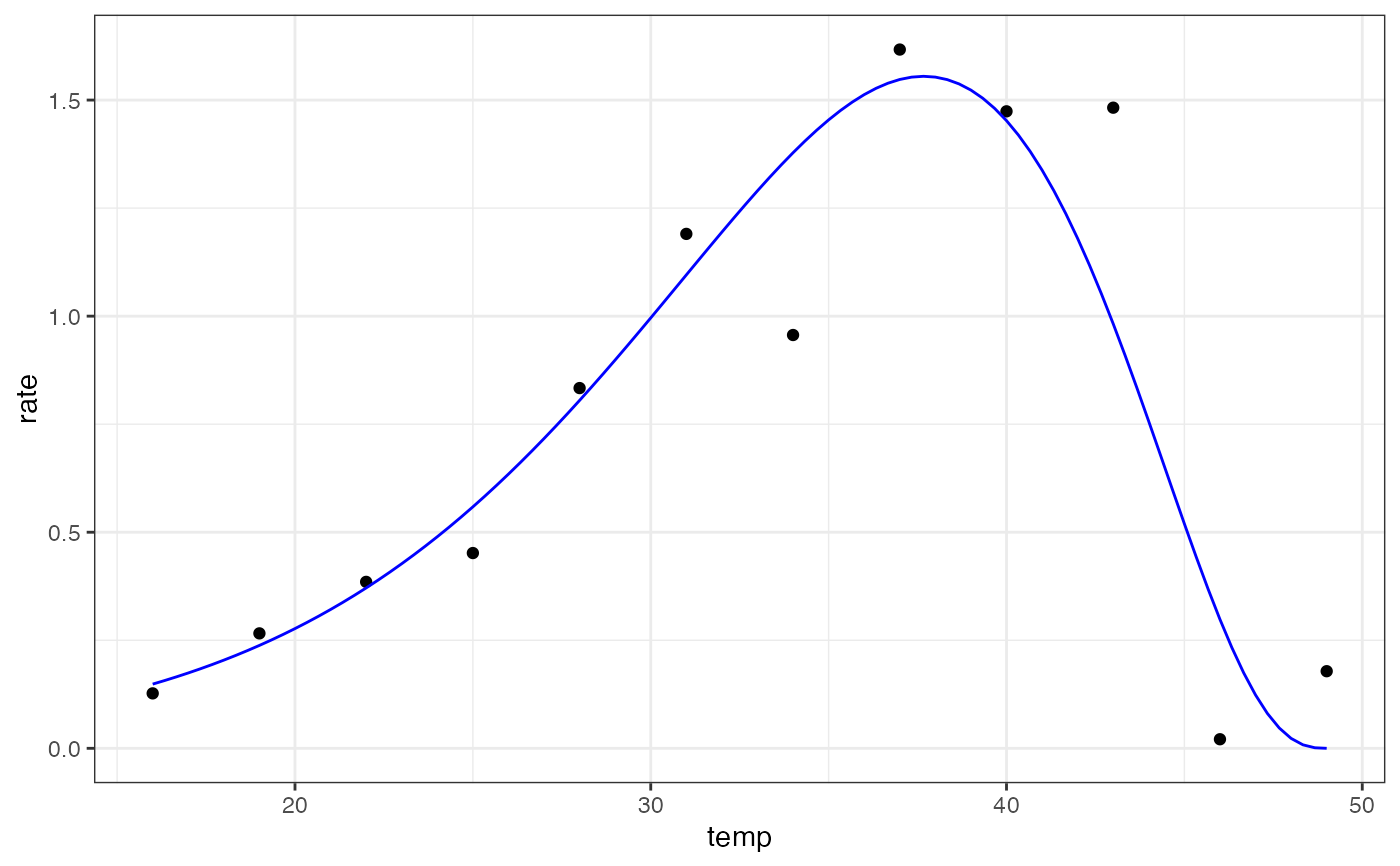O'Neill model for fitting thermal performance curves
Value
a numeric vector of rate values based on the temperatures and parameter values provided to the function
Details
Equation: $$rate = r_{max} \cdot \bigg(\frac{ct_{max} - temp}{ct_{max} - t_{opt}}\bigg)^{x} \cdot exp^{x \cdot \frac{temp - t_{opt}}{ct_{max} - t_{opt}}}$$ $$where: x = \frac{w^{2}}{400}\cdot\bigg(1 + \sqrt{1 + \frac{40}{w}}\bigg)^{2}$$ $$and:\ w = (q_{10} - 1)\cdot (ct_{max} - t_{opt})$$
Start values in get_start_vals are derived from the data and previous values in the literature
Limits in get_lower_lims and get_upper_lims are based on extreme values that are unlikely to occur in ecological settings.
References
O’Neill, R.V., Goldstein, R.A., Shugart, H.H., Mankin, J.B. Terrestrial Ecosystem Energy Model. Eastern Deciduous Forest Biome Memo Report Oak Ridge. The Environmental Sciences Division of the Oak Ridge National Laboratory. (1972)
Examples
# load in ggplot
library(ggplot2)
# subset for the first TPC curve
data('chlorella_tpc')
d <- subset(chlorella_tpc, curve_id == 1)
# get start values and fit model
start_vals <- get_start_vals(d$temp, d$rate, model_name = 'oneill_1972')
# fit model
mod <- nls.multstart::nls_multstart(rate~oneill_1972(temp = temp, rmax, ctmax, topt, q10),
data = d,
iter = c(4,4,4,4),
start_lower = start_vals - 10,
start_upper = start_vals + 10,
lower = get_lower_lims(d$temp, d$rate, model_name = 'oneill_1972'),
upper = get_upper_lims(d$temp, d$rate, model_name = 'oneill_1972'),
supp_errors = 'Y',
convergence_count = FALSE)
# look at model fit
summary(mod)
#>
#> Formula: rate ~ oneill_1972(temp = temp, rmax, ctmax, topt, q10)
#>
#> Parameters:
#> Estimate Std. Error t value Pr(>|t|)
#> rmax 1.5550 0.1627 9.555 1.19e-05 ***
#> ctmax 49.0000 5.1139 9.582 1.17e-05 ***
#> topt 37.6725 1.3291 28.344 2.59e-09 ***
#> q10 1.9206 0.2243 8.562 2.67e-05 ***
#> ---
#> Signif. codes: 0 ‘***’ 0.001 ‘**’ 0.01 ‘*’ 0.05 ‘.’ 0.1 ‘ ’ 1
#>
#> Residual standard error: 0.2657 on 8 degrees of freedom
#>
#> Number of iterations to convergence: 47
#> Achieved convergence tolerance: 1.49e-08
#>
# get predictions
preds <- data.frame(temp = seq(min(d$temp), max(d$temp), length.out = 100))
preds <- broom::augment(mod, newdata = preds)
# plot
ggplot(preds) +
geom_point(aes(temp, rate), d) +
geom_line(aes(temp, .fitted), col = 'blue') +
theme_bw()

